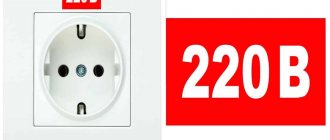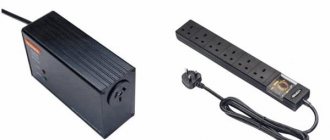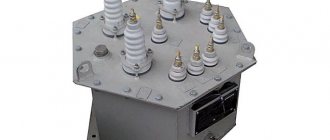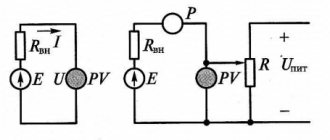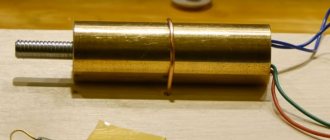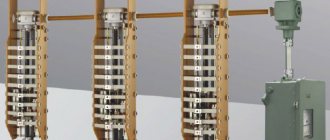- 07.07.2010
Transformer oil is used as an insulating medium in power and instrument transformers, oil-filled bushings and switches.
The operating conditions of the oil in electrical equipment (heating by operating current, the action of a burning arc, contamination by particles of solid fibrous insulation, moisture from contact with the environment, etc.) place quite stringent requirements on it.
Before pouring into equipment, fresh transformer oil must be tested in accordance with the requirements of the PUE. Operating transformer oil is tested in accordance with the requirements of PEEP.
For testing, a sample of transformer oil, arrived from the manufacturer or located in electrical equipment, is taken from the bottom of the container or tank of the equipment, after first flushing the drain hole with oil. The container in which the oil sample is taken must be clean and well dried.
The minimum breakdown voltage of the oil is determined on devices of the AMI-80 or AII-70M type in an oil breakdown vessel with a standard spark gap, which consists of two flat brass electrodes 8 mm thick with rounded edges and a diameter of 25 mm with a distance between the electrodes of 2.5 mm.
Before testing, the jar or bottle with the oil sample is slowly turned upside down several times, ensuring that there are no air bubbles in the oil. The porcelain vessel in which the oil is tested, together with the electrodes, is rinsed three times with oil. Oil is poured onto the walls of the vessel and electrodes in a thin stream to prevent the formation of air bubbles. After each rinse, drain the oil completely.
The level of filled oil in the vessel should be 15 mm above the top edge of the electrode. The protective oil needs to sit in the vessel for 15-20 minutes. to remove air bubbles. The voltage increases until breakdown occurs smoothly at a speed of 1-2 kV/s. After a breakdown, which is marked by a spark between the electrodes, the voltage is reduced to zero and increased again until the next breakdown. A total of six breakdowns are made with intervals between them of 5-10 minutes. After each breakdown, carbonized oil particles are removed from the gap between the electrodes with glass or metal clean rods by stirring. The liquid is then allowed to settle for 10 minutes.
The voltage at which the first breakdown occurs is not taken into account. The breakdown voltage of transformer oil is determined as the arithmetic average of five subsequent breakdowns.
Frequency of oil testing in power transformers
Type of test Voltage 110 kV and higher (power over 630 kVA) Voltage 110 kV and higher (power up to 630 kVA) Voltage 35 kV Block transformers, TSN and transformers with an average annual load of at least 50% of the rated load. (35 kV) Voltage 35 kV and above Voltage 35 kV and below HARG1) During the first 3 days; 2) After 10 days; 3) 1, 3, 6 months after switching on, then 2 times a year. During the first 3 days after switching on—During the first 3 days. after switching on - after 1 and 6 months. after switching on - then at least 2 times a year - Before commissioning - Before and after completion of major and restoration repairs of the transformer and/or work with oil - Punchdown UAfter commissioning: 1) 110-220 kV - after 10 days and 1 month; 2) 330-750 kV - after 10 days, 1 and 3 months. 3) In the future - at least 1 time in 2 years It is allowed not to test———During the first month of operation (1 time in the first half and 1 time in the second half of the month) and after a year. Further, at least once every 4 years Flash point After commissioning: 1) 110-220 kV - after 10 days and 1 month; 2) 330-750 kV - after 10 days, 1 and 3 months. 3) In the future - at least 1 time in 2 years It is allowed not to test - - - At least 1 time in 4 years Moisture content After commissioning: 1) 110-220 kV - after 10 days and 1 month; 2) 330-750 kV - after 10 days, 1 and 3 months. 3) In the future - at least 1 time in 2 years It is allowed not to test———At least 1 time in 4 years Mechanical impurities After commissioning: 1) 110-220 kV - after 10 days and 1 month; 2) 330-750 kV - after 10 days, 1 and 3 months. 3) In the future - at least once every 4 years————Acid number After commissioning: 1) 110-220 kV - after 10 days and 1 month; 2) 330-750 kV - after 10 days, 1 and 3 months. 3) In the future - at least 1 time in 2 years It is allowed not to test———At least 1 time in 4 years Acids and alkalis After commissioning: 1) 110-220 kV - after 10 days and 1 month; 2) 330-750 kV - after 10 days, 1 and 3 months. 3) In the future - at least once every 4 years It is allowed not to test————Tangent After commissioning: 1) 110-220 kV - after 10 days and 1 month; 2) 330-750 kV - after 10 days, 1 and 3 months. 3) In the future - at least 1 time in 4 years It is allowed not to test————Ionol, Agidol At least 1 time in 4 years It is allowed not to test————Furan 1 time in 12 years. After 24 years of operation: 1 time every 4 years. It is also recommended to determine if significant amounts of CO and CO2 are detected in transformer oil by chromatographic analysis of dissolved gases———By the decision of the technical manager Total gas content For transformers with film protection after commissioning: 1) 110-220 kV - after 10 days and 1 month; 2) 330-750 kV - after 10 days, 1 and 3 months. 3) In the future - at least once every 4 years—————Degree of polymerization In case, according to indirect assessment methods (presence of furan derivatives in transformer oil, results of chromatographic analysis of furan compounds dissolved in oil, CO and CO2 gases, results of physical - chemical analysis of oil, results of measuring the dielectric parameters of insulation) there are sufficient grounds to expect significant wear of solid insulation For critical transformers that have worked within the time limits established by the regulatory and technical documentation (block transformers, auxiliary transformers), under the above conditions———Stability against oxidationBefore commissioning ————2.3.5. Determination of the C2/C50 ratio.
Carried out during a major overhaul. Measuring the C2/C50 ratio is not necessary for transformers with a power of up to 1000 kVA. In addition, measurements are not made for dry transformers of all capacities.
Measurements of the C2/C50 ratio must be made at the same temperature or referred to the same temperature.
The highest permissible values C2/C50 of insulation of transformer windings in oil are presented in table. 2.19.
The procedure for measuring the C2/C50 ratio should also be guided by the instructions in paragraph 2.2.3.
Table 2.19. The highest permissible values C2/C50 of insulation of transformer windings in oil
| Transformer voltage, kV | C2/C50 values at temperature, °C | ||||||
| 10 | 20 | 30 | 40 | 50 | 60 | 70 | |
| up to 35 | 1,2 | 1,3 | 1,4 | 1,5 | 1,6 | 1,7 | 1,8 |
| 110-150 | 1,1 | 1,2 | 1,3 | 1,4 | 1,5 | 1,6 | 1,7 |
| Over 150 | Not standardized | ||||||
Note : Table data. 5 PEEP.
Frequency of oil testing in on-load tap-changer
Type of test All voltage classes HARG—Breakthrough U At least once a year Flash point—Moisture content At least once a year Mechanical impurities—Acid number—Acids and alkalis—Tangent—Ionol, Agidol—Furan—Total gas content—Degree of polymerization—Stability against oxidation—Physical properties
The physical properties of transformer oil are regulated by the technical process and are important for its correct execution.
The main factors studied when analyzing physical properties are:
- rate of ice formation - ice forming on the surface falls to the bottom, providing circulation to the inoperative transformer. Normal conditions assume that the specific gravity of the substance is less than that of ice;
- flash point - it should be as high as possible; its decrease over time makes the transformer a fire hazard. The breakdown of the structure of transformer oil into its components leads to a sharp decrease in the flash point.
If the physical properties of transformer oil are compromised, this indicates product fatigue and the need to replace it.
Frequency of high-voltage bushing oil testing
Types of testing Unsealed bushing 110-220 kV Unsealed bushing 330-500 kV Sealed bushing, all voltages HARG———Breakdown U1 once every 4 years 1 time every 2 years Produced upon receipt of unsatisfactory results in the subparagraphs: “Measurement of insulation resistance” and/or “Measurement of tangent and insulation capacitance” , and/or “Insulation monitoring under operating voltage”, as well as when the pressure in the bushing increases above the permissible values regulated by the manufacturer’s documentation for the bushings. Flash point 1 time every 4 years 1 time every 2 years Produced when unsatisfactory results are obtained in the subparagraphs: “Resistance measurement insulation” and/or “Measurement of tangent and insulation capacity”, and/or “Insulation monitoring under operating voltage”, as well as when the pressure in the bushing increases above the permissible values regulated by the manufacturer’s documentation for the bushings. Moisture content 1 time every 4 years 1 time every 2 years Performed upon receipt of unsatisfactory results in the subparagraphs: “Measurement of insulation resistance” and/or “Measurement of tangent and capacitance of insulation”, and/or “Control of insulation under operating voltage”, as well as when the pressure in the input increases above the permissible values regulated manufacturer's documentation for the bushings. Mechanical impurities Tested when the results of steps 2-4 are unsatisfactory (breakdown voltage, flash point, moisture content) Performed when unsatisfactory results are obtained in subparagraphs: “Measurement of insulation resistance” and/or “Measurement of tangent and insulation capacitance”, or ( i) “Insulation monitoring under operating voltage”, as well as when the pressure in the bushing increases above the permissible values regulated by the manufacturer’s documentation for the bushings. Acid number 1 time every 4 years 1 time every 2 years Performed upon receipt of unsatisfactory results in the subparagraphs: “Measurement of insulation resistance” or (i) “Measurement of tangent and insulation capacitance”, or (and) “Insulation monitoring under operating voltage”, as well as when the pressure in the bushing increases above the permissible values regulated by the manufacturer’s documentation for the bushings. Acids and alkalis Tested if the results are unsatisfactory p 2-4 (breakdown voltage, flash point, moisture content) Performed when unsatisfactory results are obtained in the subparagraphs: “Measurement of insulation resistance” and/or “Measurement of tangent and insulation capacitance”, and/or “Insulation monitoring under operating voltage”, as well as when increasing pressure in the bushing exceeds the permissible values regulated by the manufacturer's documentation for the bushings. Tangent Tested when the results of steps 2-4 (breakdown voltage, flash point, moisture content) are unsatisfactory. Performed when unsatisfactory results are obtained in the subparagraphs: “Measurement of insulation resistance” and/or “Measurement of tangent and insulation capacity”, and/or “Insulation monitoring under operating voltage”, as well as when the pressure in the bushing increases above the permissible values regulated by the manufacturer’s documentation for the bushings. Ionol, Agidol Tested if the results of paragraph 2-4 are unsatisfactory (breakdown voltage, flash point , moisture content)—FuranTested when the results of p. 2-4 are unsatisfactory (breakdown voltage, flash point, moisture content) Produced when unsatisfactory results are obtained in subparagraphs: “Measurement of insulation resistance” and/or “Measurement of tangent and insulation capacitance”, and/or “Insulation control under operating voltage”, as well as when the pressure in the bushing increases above the permissible values regulated by the manufacturer’s documentation for the bushings. Total gas content Tested when the results of steps 2-4 are unsatisfactory (breakdown voltage, flash point, moisture content) Performed when unsatisfactory results are obtained in subparagraphs : “Measurement of insulation resistance” and/or “Measurement of tangent and capacitance of insulation”, and/or “Control of insulation under operating voltage”, as well as when the pressure in the bushing increases above the permissible values regulated by the manufacturer’s documentation for the bushings. Degree of polymerization— ——Oxidation stability———1. GENERAL PROVISIONS
1.1. These Guidelines apply to domestic and imported petroleum oils of all brands used in general-purpose electrical equipment.
1.2. Operation of transformer oils must be carried out in accordance with the requirements of regulatory and technical documents.
https://www.youtube.com/watch?v=upload
1.3. Based on these Guidelines, energy enterprises should develop local instructions taking into account specific conditions (design of high-voltage equipment, equipment for oil facilities, brands of oils used, etc.), in order to provide the full range of necessary measures to maintain the quality of transformer oils and increase their service life. With proper use of transformer oils, their service life should correspond to the service life of electrical equipment.
Frequency of oil testing in current transformers
Types of testing Voltage 110 kV and above, the CT is not equipped with a control system under operating voltage Voltage 110 kV and above, the CT is equipped with a control system under operating voltage Voltage 35 kV and below HARG———Breakdown U1 once every 4 years Upon reaching the controlled parameters of the limit values given in Table 10.1.3 During operation allowed not to test Flash point 1 time in 2 years Once the controlled parameters reach the limit values given in table 10.1.3 During operation, it is allowed not to test Moisture content 1 time in 2 years After the controlled parameters reach the limit values given in table 10.1.3 During operation, it is allowed not to test Mechanical impurities Tested if the results are unsatisfactory p 1-4 (HARG, breakdown voltage, flash point, moisture content) Once the controlled parameters reach the limit values given in table 10.1.3 During operation, it is allowed not to test Acid number 1 time in 4 years 1 time in 2 years During operation it is allowed not to test Acids and alkalis Tested at unsatisfactory results of paragraphs 1-4 (HARG, breakdown voltage, flash point, moisture content) During operation, it is allowed not to test Tangent Tested if the results of paragraph 1-4 are unsatisfactory (HARG, breakdown voltage, flash point, moisture content) During operation, it is allowed not to test Ionol, Agidol— ——Furan———Total gas content———Degree of polymerization———Oxidation stability———j) control of soluble oxidation products - soluble sludge
Experience shows that there is virtually no soluble sludge in the oil while the adsorbing filter is operating. The guidance document RD 34.43.105-89 requires periodic monitoring of this parameter. This takes advantage of the fact that the sludge becomes insoluble when the oil is diluted with H-heptane, but dissolves in a mixture of equal amounts of toluene and 95% ethyl alcohol. A series of chemical reactions allows you to determine the amount of sludge. There should be no more than 0.005% of its mass in the operating oil. There should be no soluble sediment in fresh and regenerated oils.
Oil test frequency Voltage transformers
Types of testing Voltage 110-220 kV Voltage 330-500 kV Voltage 35 kV and below HARG———Breakdown U1 once every 4 years 1 time every 2 years During operation it is allowed not to test Flash point 1 time every 4 years 1 time every 2 years During operation it is allowed not to test Moisture content 1 time every 4 years 1 time every 2 years During operation it is allowed not to test Mechanical impurities Tested if the results of points 1-4 are unsatisfactory (HARG, breakdown voltage, flash point, moisture content) During operation it is allowed not to test Acid number 1 time every 4 years 1 time every 2 years During operation it is allowed not to test Acids and alkalis Tested if the results are unsatisfactory p 1-4 (HARG, breakdown voltage, flash point, moisture content) During operation it is allowed not to test Tangent Tested if the results are unsatisfactory p 1-4 (HARG, breakdown voltage, flash point, moisture content) During operation it is allowed not to test Ionol, Agidol——— Furan———Total gas content———Degree of polymerization———Oxidation stability———Purpose of the document
In manufacturing companies, testing is part of routine activities. They allow you to install:
- quality of manufactured products,
- determine the degree of its suitability for further operation in various conditions, including non-standard ones,
- confirm its compliance with the declared properties.
The technical characteristics of the object, all stages of testing are entered into the test report, and then the results are summed up for each of them. The final part of the protocol includes a summary summary.
It should be noted that in some cases, enterprises engage other companies or specialized laboratories for testing that have the necessary equipment and experience in testing certain objects - this practice is especially common if testing requires a special license.
Oil Test Frequency High Voltage Circuit Breakers
Types of testingTank switches e.g. 110 kV and above Tank switches for voltage up to 35 kV inclusive and low-oil switches for all voltage classes Tank switches for voltage 35 kVHARG———Breakdown UWhen they perform the maximum permissible number of switchings (openings and closings) of short-circuit currents or load currents without repair. At least once every 4 years After they have completed the maximum permissible number of switchings of short-circuit currents (or load currents), they are not subject to testing, since they must be replaced with oil prepared for pouring into electrical equipment. For all repairs Flash point———Moisture content When they have completed the maximum permissible number without repair switchings (disconnections and switching on) of short-circuit currents or load currents. After they have completed the maximum permissible number of switchings of short-circuit currents (or load currents), they are not subject to testing, since they must be replaced with oil prepared for pouring into electrical equipment.—Mechanical impurities When they have fulfilled the maximum permissible without repair the number of switchings (disconnections and switching on) of short-circuit currents or load currents. After they have completed the maximum permissible number of switchings of short-circuit currents (or load currents), they are not subject to testing, since they must be replaced with oil prepared for pouring into electrical equipment.—Acid number———Acids and alkalis—After they have performed the maximum permissible number of short-circuit current (or load current) switchings, they are not subject to testing, since they must be replaced with oil prepared for pouring into electrical equipment.—Tangent—After they have performed the maximum permissible number of short-circuit current (or load current) switchings, they are not tested subject, as it must be replaced with oil prepared for filling into electrical equipment.—Ionol, Agidol———Furan———Total gas content———Degree of polymerization———Stability against oxidation———Breakdown of liquid dielectrics
The breakdown of liquid dielectrics is a complex phenomenon that is still being studied. One of the main theories of origin is as follows. If a dielectric (oil) is exposed to high voltage for a long time, and there are inclusions in the oil, then these inclusions are polarized and combined into chains that extend along the electromagnetic field lines. The circuits become a channel through which electric current flows. The current heats the liquid adjacent to the channel to a boil, and breakdown occurs through the resulting gas channel.
In thoroughly refined oils, breakdown can occur due to impact ionization of molecules. After a breakdown, the electrical insulating properties of the oil are restored, but its quality usually deteriorates noticeably.
Protocol validity period
This document is not valid for an indefinite period. The period of its validity for mandatory examinations, established at the state level, is determined by the time the tests are carried out.
- If this is the first time , then the validity period of the document is one year ,
- for any subsequent tests , the period of relevance increases to six years .
In cases with private companies and products whose tests are carried out on the personal initiative of the organization’s management, the validity period of the protocol is determined on an individual basis.


